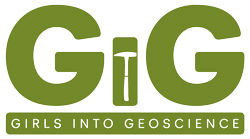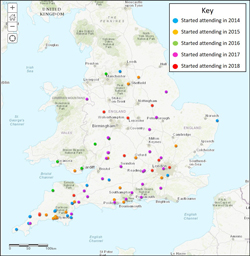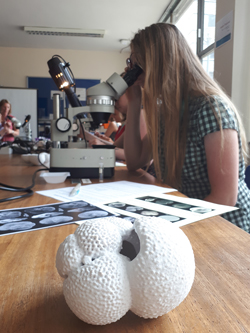Jodie Fisher and Sarah Boulton argue that to retain women in STEM careers we first need to raise awareness and pique their interest during childhood
Fisher, J. & Boulton, S., Girls into Geoscience: Where as we now?
Geoscientist 29 (4), 16-19, 2019
https://doi.org/10.1144/geosci2019-022;
Download the pdf here

Women geologists. We’ve certainly come a long way since Martine Bertereau, the first recorded female mineralogist, who was imprisoned for witchcraft in 1642. In the last 100 years, women have been elected onto learned societies, taken positions as geologists in industry, at national surveys, and increased in numbers in academia. However, there is still work to do. Whilst we have greater understanding of what is needed to retain women in science, technology, engineering and mathematics (STEM) professions, and a variety of initiatives exist to tackle bias and inequality in the workplace, women still only make up 22% of the UK STEM workforce (2018 Workforce statistics;
https://www.wisecampaign.org.uk/statistics/2018-workforce-statistics/).
A similar pattern is seen in the geosciences, and although the number of females undertaking geology degrees in the UK has risen to about 40 % of total student numbers over the last five years, we can still do more to challenge stereotypes within the Earth and physical sciences, to empower women to continue on into STEM careers, and to help retain women as their careers develop. But, in order to retain women in STEM, we clearly need to do something to get girls interested in the first place.
Addressing imbalance
To address the gender imbalance in geoscience, in 2014, we began Girls into Geoscience (GiG). GiG is an outreach initiative primarily based around an annual two-day event held at the University of Plymouth, and this year sees the 6th annual event taking place on July 1-2. Aimed at year 12 (aged 16-17) female students who are thinking about applying for university, we welcome all students who are interested in geoscience, from those who have studied geology, have some geological knowledge, or are completely new to the geosciences.
On day one we offer an optional fieldtrip, to demonstrate that there are no barriers to female inclusion in the field. In 2016 and 2017, we visited Dartmoor National Park, and last year we headed to Torbay to find out about sedimentology and palaeontology. A day in the field introduces the students to the observation and description of geological materials and features, while giving the girls the chance to get a taste of fieldwork.
The second day consists of morning talks and afternoon workshops, with topics from across the geosciences. The talks showcase the range of geoscience career pathways that are possible from across industry and academia, and importantly provide role models for the girls. Speakers span the career spectrum, from early career to experienced scientists, and they talk about their unique journey to becoming Earth Scientists, as well as informing the students about the different disciplines and roles possible after graduation. The girls then network over lunch with the speakers, as well as with staff and female students studying the Earth sciences at the University of Plymouth. In the afternoon, an insight into the university experience is given through hands-on workshops, again across a range of geoscience topics.
Since 2014, 328 girls from schools across the country (Fig.1) have attended these two-day GiG events. Feedback from the girls and teachers has been fantastic. One student said, “Amazing event, would recommend to anyone thinking of a career in geoscience”, while another commented “Lovely to get a hands-on experience with the different areas in geology, especially using real samples under the microscopes”. Others appreciated the opportunity to network with likeminded girls: “I think it was really great to meet girls with similar interests to myself and all learning new things at the same time”.
 Figure 1, Map to show the school locations that girls attending GiG are coming from. © Jodie Fisher, base map from ESRI.
Figure 1, Map to show the school locations that girls attending GiG are coming from. © Jodie Fisher, base map from ESRI.
Monitoring progress
This qualitative feedback has enabled us to adapt the fieldtrip, talks and workshops to the girls’ interests. However, to properly monitor our impact on getting girls into geoscience over the last six years, further evaluation has been key. A post-event questionnaire on the day and a follow-up questionnaire to attendees a year later allows us to track the students through their university application process. These data have enabled us to fully monitor if, and how, attending GiG may have shaped girls’ ideas about the geosciences, and establish if the girls have chosen to take a geoscience degree at university. These data are summarised in table 1. 84% of our 2018 attendees said they were more likely to consider the geosciences following GiG18, so we are looking forward to hearing from them later this year as we continue to monitor our impact on the progression of women into geoscience degree programmes.
 Table 1: Summary of survey results showing the impact of attending GiG on studying geoscience at university, both immediately after the event and one year later.
Table 1: Summary of survey results showing the impact of attending GiG on studying geoscience at university, both immediately after the event and one year later.
These data show the significant impact that this event has had on university degree choices of the students. And it doesn’t stop there. With our first attendees now graduating from university we are seeing them entering into their own careers, and it is wonderful to hear their stories. For example, Jessica Kitch from Bridgewater College in Somerset attended GiG2014, and following her graduation from the University of Plymouth is now working as a research technician on soil erosion in Latin America. Jessica is also part of the organising team of GiG19, sharing her experience with the next generation.
If you have attended one of our GiG events, and are now embarking on your own geoscience career or degree course, do get in touch, we’d love to hear from you!
Expansion
Since 2014, GiG has evolved and developed. Growing from a one-day event, to a network of girls, academics, teachers and industry geoscientists. We have seen the event become residential, include a fieldtrip and become international, with GiG Ireland joining the team in 2017 (holding 2 events in 2018, and the next taking place in Dublin in November 2019) and GiG Scotland scheduled to run for the first time this August at the University of Glasgow. We have been invited to provide editorials and articles for a number of geoscience journals and magazines, and were awarded the Geological Society’s premier outreach award—the R H Worth Prize in 2018.
Social networking has also proven key in expanding the GiG network. Our Twitter account (
@girlsingeosci) is successfully engaging potential attendees, female geoscientists and others keen on supporting women into the geosciences. We have 1,764 followers and regularly reach more than 5,000 people with our tweets. We have a blog (
https://girlsintogeoscience.wordpress.com/) that has similarly affected people globally, with hits from more than 100 countries and over 6,500 visitors since 2016. In 2018, we also launched our ESRI (Environmental Systems Research Institute) Crowdsource Story map (
https://arcg.is/1SuO0i), which saw more than 375 women globally show where geoscience has taken them, showcasing an inspiring range of field locations, geocareers, and role models.
Going forward
However, we realise there is still more we can do in order to break down the barriers that may exist to females when thinking about STEM subjects and careers. Many girls make their career choices by the time they are 14, and gender stereotypes about potential careers are set as early as the age of four, with seven-year-old’s career aspirations being strongly shaped by gender-specific ideas about certain jobs (Drawing the Future 2018;
https://www.educationandemployers.org/wp-content/uploads/2018/01/DrawingTheFuture.pdf). So, whilst we are promoting STEM and the geosciences to girls interested in knowing more, we may already be too late for many girls who have already ruled out STEM subjects.
 © Sarah Boulton
© Sarah Boulton
Consequently, this year we are launching a secondary GiG event for year 8 and 9 girls (aged 12-14) to get these younger girls inspired by STEM and show them where the geosciences could take them. Linking with other universities (initially the universities of Leicester and Hull) we hope to develop a network of smaller hub events across the country, in turn feeding into the larger initiative and broadening our network. The University of Leicester will be holding the first ‘Junior GiG’ event in October, during Earth Science Week 2019.
GiG is growing, and following the launch of GiG Ireland, GiG Scotland, and international links with the American Association of Women Geoscientists, we are creating a multinational network for women in the geosciences. With additional links to professional bodies in the UK, and the promotion of our initiative at key events across the UK we are excited to see where GiG will take us in the future!
Dr Jodie Fisher and Dr Sarah Boulton are both at the University of Plymouth
Acknowledgements
We thank all the students, teachers, families, sponsors and GiG team members without whom these events would not be possible.
Further information
Booking is now open for both GiG19 at the University of Plymouth, 1-2 July 2019 (
https://www.plymouth.ac.uk/whats-on/girls-into-geoscience) and for GiG Scotland at the University of Glasgow, 1 August 2019 (
https://www.gla.ac.uk/schools/ges/excellenceinteaching/girlsintogeoscience/).
The University of Leicester will hold its first GiG Junior event on 16 October 2019 and will be opening for bookings soon!
GiG Ireland, 16 November at University College Dublin will be opening for bookings soon
https://girlsintogeoscienceireland.wordpress.com/